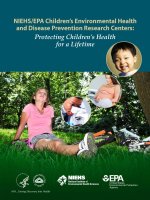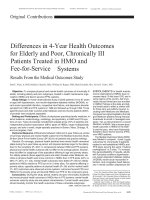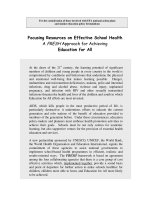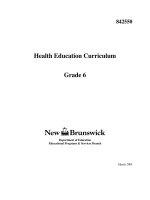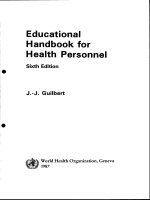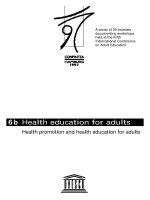Wisconsin standards for Health Education ppt
Bạn đang xem bản rút gọn của tài liệu. Xem và tải ngay bản đầy đủ của tài liệu tại đây (1.75 MB, 49 trang )
Wisconsin Department of Public Instruction
Wisconsin standards for
Health Education
Wisconsin Standards for
Health Education
Jon Hisgen, MS, CHES
Health and Physical Education Consultant
Wisconsin Department of Public Instruction
Tony Evers, PhD, State Superintendent
Madison, Wisconsin
D11017_WI_SHE.indd 1 11/16/11 12:52 PM
This publication is available from:
STUDENT SERVICES/PREVENTION AND WELLNESS TEAM
Wisconsin Department of Public Instruction
125 South Webster Street
Madison, WI 53703
(608) 266-8960
/>Bulletin No. 20210
© November 2011 Wisconsin Department of Public Instruction
ISBN NUMBER 978-1-57337-149-0
The Wisconsin Department of Public Instruction does not discriminate on the basis of sex, race,
color, religion, creed, age, national origin, ancestry, pregnancy, marital status
or parental status, sexual orientation, or disability.
Copyrighted Materials
Every effort has been made to ascertain proper ownership on copyrighted materials and to obtain
permission for this use. Any omission is unintentional.
The standards and parts of the learning continuum were reprinted with permission from the American
Cancer Society, National Health Education Standards: Achieving Excellence, Second Edition
(Atlanta, GA: American Cancer Society).
Printed on recycled paper
D11017_WI_SHE.indd 2 11/28/11 1:34 PM
Foreword
iii
Foreword
I
magine a Wisconsin in which all students are fit, healthy, and ready to learn;
where all students have the essential skills to live a healthy and productive
life. Imagine that young people successfully apply the skills they learn in
health education to real-life, challenging situations throughout their teen and
adult years. At a time when many forces pressure students to make decisions
that can compromise their well-being, health-related skills and knowledge are
important parts of ensuring every child graduates prepared for success.
To clearly identify what students should know and be able to do in order to
lead healthy lives, the Wisconsin Department of Public Instruction created the
Wisconsin Standards for Health Education. This document builds upon earlier
efforts, including the Wisconsin Model Academic Standards (1997) and the
National Health Education Standards (2006).
The Wisconsin Standards for Health Education provides a framework for
aligning health education curriculum, instruction, and assessment. In the fall
and winter of 2010/11 a team of elementary, middle school, high school, higher
education health educators, and administrators created this document with the
assistance of Wisconsin Health and Physical Education (WHPE); the Wisconsin
Association for Supervision and Curriculum Development; the Association of
Wisconsin School Administrators; and the Wisconsin Education Association
Council. This team built upon the national standards and developed a rigorous
K–12 learning continuum. The new health education standards include the
following components:
• Broad statements of essential student knowledge and skills.
• A rationale for each of the eight health education standards.
• Learning priorities to help school districts develop effective K–12 health
education curricula.
• Focus areas to guide teachers regarding the types of health education
instruction that will best help students meet the standards.
• A PK–12 learning continuum that provides grade band descriptions for
each learning priority.
Taken together, the components of this standards document can help parents,
school personnel, and other community members in their work to teach students
what they need to be able to do to lead healthier lifestyles.
Tony Evers, PhD
State Superintendent
D11017_WI_SHE.indd 3 11/17/11 1:54 PM
D11017_WI_SHE.indd 4 11/18/11 7:15 AM
Acknowledgments
The Wisconsin Standards for Health Education would not have been possible without the efforts of many
people. Members of the task force freely gave their time and expertise in developing the academic standards.
In addition, their employing agencies generously granted them time to work on this initiative. The task force
members are:
Eric Blake
Principal
Waterford Union High School
Waterford, Wisconsin
Steve Borgman
Health and Physical
Education Teacher
Westside Elementary School
Sun Prairie, Wisconsin
Tracy Caravella
Associate Professor
Health Education
University of Wisconsin-La Crosse
La Crosse, Wisconsin
Crystal Gorwitz
Health and Physical
Education Teacher
Hortonville Middle School
Hortonville, Wisconsin
Cristy Jefson
Associate Professor
Health Education
University of Wisconsin-Whitewater
Whitewater, Wisconsin
Kim Leupold
Health and Physical
Education Teacher
Brookfield East High School
Brookfield, Wisconsin
Maredda Magnus
Health and Physical
Education Teacher
Somers Elementary School
Kenosha, Wisconsin
Pam Pinahs-Schultz
Professor
Health and Physical Education
Carroll University
Waukesha, Wisconsin
Lisa Strauss
Health and Physical
Education Teacher
Templeton Middle School
Sussex, Wisconsin
Marcus Wenzel
Health and Physical
Education Teacher
Milwaukee Public Schools
Milwaukee, Wisconsin
Department of Public Instruction Staff
Jon W. Hisgen, Consultant
Health and Physical Education
Emily Holder, Consultant
HIV/STI Prevention and Human Growth and
Development
Jill Camber Davidson, Consultant
Nutrition Education
Linda Carey
Office Operations Associate
Douglas White, Director
Student Services/Prevention and Wellness
Development of this document was supported in part by Cooperative Agreement #5U87DP001204-3 with the
Centers for Disease Control and Prevention, Division of Adolescent and School Health.
Acknowledgments
v
D11017_WI_SHE.indd 5 11/16/11 12:54 PM
D11017_WI_SHE.indd 6 11/16/11 12:54 PM
Table of Contents
Foreword . . . . . . . . . . . . . . . . . . . . . . . . . . . . . . . . . . . . . . . . . . . . . . . . . . . . . . . . . . . . . . . . . . . . . iii
Acknowledgments . . . . . . . . . . . . . . . . . . . . . . . . . . . . . . . . . . . . . . . . . . . . . . . . . . . . . . . . . . . . . . .v
Aligning.for.Student.Success. . . . . . . . . . . . . . . . . . . . . . . . . . . . . . . . . . . . . . . . . . . . . . . . . . . . . . . ix
Guiding.Principles.for.Teaching.and.Learning . . . . . . . . . . . . . . . . . . . . . . . . . . . . . . . . . . . . . . . . . . xi
Reaching.Every.Discipline:.Wisconsin’s.Approach.to.Disciplinary.Literacy . . . . . . . . . . . . . . . . . . . xiii
Guide.to.the.Wisconsin Standards for Health Education. . . . . . . . . . . . . . . . . . . . . . . . . . . . . . . . . . 1
Coding.System . . . . . . . . . . . . . . . . . . . . . . . . . . . . . . . . . . . . . . . . . . . . . . . . . . . . . . . . . . . . . . . . . 3
Why.Children.Need.Health.Education . . . . . . . . . . . . . . . . . . . . . . . . . . . . . . . . . . . . . . . . . . . . . . . 5
Wisconsin Standards for Health Education:.Critical.Questions . . . . . . . . . . . . . . . . . . . . . . . . . . . . 7
Section 1 Vertical Alignment of the Standards-Based Learning Continuum . . . . . . . . . . . . . 13
Standard.1:.Students.will.comprehend.concepts.related.to.health.promotion.
and.disease.prevention.to.enhance.health . . . . . . . . . . . . . . . . . . . . . . . . . . . . . . . . . . . . . . . .14
Standard.2:.Students.will.analyze.the.influence.of.family,.peers,.culture,.media,.
technology,.and.other.factors.on.health.behaviors . . . . . . . . . . . . . . . . . . . . . . . . . . . . . . . . .17
Standard.3:.Students.will.demonstrate.the.ability.to.access.valid.information.
and.products.and.services.to.enhance.health. . . . . . . . . . . . . . . . . . . . . . . . . . . . . . . . . . . . . .19
Standard.4:.Students.will.demonstrate.the.ability.to.use.interpersonal.communication.
skills.to.enhance.health.and.avoid.or.reduce.health.risks . . . . . . . . . . . . . . . . . . . . . . . . . . . 21
Standard.5:.Students.will.demonstrate.the.ability.to.use.decision-making.skills.
to.enhance.health . . . . . . . . . . . . . . . . . . . . . . . . . . . . . . . . . . . . . . . . . . . . . . . . . . . . . . . . . 24
Standard.6:.Students.will.demonstrate.the.ability.to.use.goal-setting.
skills.to.enhance.health. . . . . . . . . . . . . . . . . . . . . . . . . . . . . . . . . . . . . . . . . . . . . . . . . . . . . . 27
Standard.7:.Students.will.demonstrate.the.ability.to.use.health-enhancing.
behaviors.and.avoid.or.reduce.health.risks. . . . . . . . . . . . . . . . . . . . . . . . . . . . . . . . . . . . . . . 29
Standard.8:.Students.will.demonstrate.the.ability.to.advocate.for.personal,.
family,.and.community.health . . . . . . . . . . . . . . . . . . . . . . . . . . . . . . . . . . . . . . . . . . . . . . . . 32
Section 2 Grade Band Alignment of the Standards-Based Learning Continuum . . . . . . . . . 35
Section 3 Appendices . . . . . . . . . . . . . . . . . . . . . . . . . . . . . . . . . . . . . . . . . . . . . . . . . . . . . . . . . 59
Glossary.of.Terms
Health.Resources
Health.Education.and.Literacy:.Making.Connections
Common.Core.State.Standards.for.Literacy.in.All.Subjects
Table of Contents
vii
D11017_WI_SHE.indd 7 11/18/11 7:29 AM
D11017_WI_SHE.indd 8 11/16/11 12:55 PM
Aligning for Student Success
ix
Aligning for Student
Success
To build and sustain schools that support every student in achieving success,
educators must work together with families, community members, and business
partners to connect the most promising practices in the most meaningful
contexts. Major statewide initiatives focus on high school graduation, Response
to Intervention (RtI), the Common Core State Standards for English Language
Arts, Disciplinary Literacy, and Mathematics, and academic standards. While
these are often viewed as separate efforts and initiatives, each of them is
connected to a larger vision of every child graduating college and being career-
ready. The graphic below illustrates how these initiatives function together
for a common purpose. Here, the vision and set of guiding principles form the
foundation for building a supportive process for teaching and learning rigorous
and relevant content. The following sections articulate this integrated approach
to increasing student success in Wisconsin schools and communities.
A Vision: Every Child a Graduate
In Wisconsin, we are committed to ensuring every child is a graduate who has
successfully completed a rigorous, meaningful, 21st century education that
will prepare him or her for careers, college, and citizenship. Though our public
education system continues to earn nation-leading graduation rates, a fact we
can be proud of, one in ten students drop out of school, achievement gaps are
too large, and overall achievement could be even higher. This vision for every
child a graduate guides our beliefs and approaches to education in Wisconsin.
The greatest wealth is
health.
—Virgil
D11017_WI_SHE.indd 9 11/16/11 12:55 PM
x
Wisconsin Standards for Health Education
Guided by Principles
All educational initiatives are guided and impacted by important and often
unstated attitudes and principles for teaching and learning. The Guiding
Principles for Teaching and Learning emerge from research and provide the
touchstone for practices that truly affect the vision of every child a graduate
prepared for college and career. When made transparent, these principles inform
what happens in the classroom, the implementation and evaluation of programs,
and most importantly, remind us of our beliefs and expectations for students.
Ensuring a Process for Student Success
To ensure that every child in Wisconsin graduates prepared for college and
career, schools need to provide high quality instruction, balanced assessment,
and collaboration reflective of culturally responsive practices. The Wisconsin
Response to Intervention (RtI) framework helps to organize the components
of a system designed to support student learning. Below, the three essential
elements of high quality instruction, balanced assessment, and collaboration
interact with a multi-system of support to ensure each student receives what he
or she needs to access higher levels of academic and behavioral success.
At the school or district level, programs, initiatives, and practices related to
high quality instruction, balanced assessment, and collaboration can be more
powerful when organized or braided to function systemically to support all
students. The focus must be on a comprehensive approach to student learning.
Health education is a key component of a coordinated school health program.
Such programs include a healthy and safe school environment, health-related
instruction in a variety of courses, extracurricular student programs, pupil
services, health-related programs for families and staff, and strong connections
with families and the broader community.
D11017_WI_SHE.indd 10 11/16/11 12:55 PM
Guiding Principles for Teaching and Learning
xi
Guiding Principles for
Teaching and Learning
These guiding principles are the underpinnings of effective teaching and learning
for every Wisconsin teacher and every Wisconsin student. They are larger than
any one initiative, process, or set of standards. Rather, they are the lens we look
through as we identify teaching and learning standards, design assessments,
and determine what good instruction looks like. These principals recognize that
every student has the right to learn and are built upon three essential elements:
high quality instruction, balanced assessment, and collaboration. They are meant
to align with academic excellence, rigorous instruction, and college and career
readiness for every Wisconsin student.
Every student has the right to learn.
It is our collective responsibility as an education community to make certain
each child receives a high-quality, challenging education designed to maximize
potential; an education that reflects and stretches his or her abilities and interests.
This belief in the right of every child to learn forms the basis of equitable
teaching and learning. The five principles that follow cannot exist without this
commitment guiding our work.
Instruction must be rigorous and relevant.
To understand the world in which we live, there are certain things we all must
learn. Each school subject is made up of a core of essential knowledge that is
deep, rich, and vital. Every student, regardless of age or ability, must be taught
this essential knowledge. What students learn is fundamentally connected to
how they learn, and successful instruction blends the content of a discipline
with processes of an engaging learning environment that changes to meet the
dynamic needs of all students.
Purposeful assessment drives instruction and
affects learning.
Assessment is an integral part of teaching and learning. Purposeful assessment
practices help teachers and students understand where they have been, where
they are, and where they might go next. No one assessment can provide
sufficient information to plan teaching and learning. Using different types of
assessments as part of instruction results in useful information about student
understanding and progress. Educators should use this information to guide
their own practice and, in partnership with students and their families, to reflect
on learning and set future goals.
D11017_WI_SHE.indd 11 11/16/11 12:55 PM
xii
Wisconsin Standards for Health Education
Learning is a collaborative responsibility.
Teaching and learning are both collaborative processes. Collaboration benefits
teaching and learning when it occurs on several levels: when students, teachers,
family members, and the community collectively prioritize education and
engage in activities that support local schools, educators, and students; when
educators collaborate with their colleagues to support innovative classroom
practices and set high expectations for themselves and their students; and when
students are given opportunities to work together toward academic goals in
ways that enhance learning.
Students bring strengths and experiences to
learning.
Every student learns. Although no two students come to school with the same
culture, learning strengths, background knowledge, or experiences, and no two
students learn in exactly the same way, every student’s unique personal history
enriches classrooms, schools, and the community. This diversity is our greatest
education asset.
Responsive environments engage learners.
Meaningful learning happens in environments where creativity, awareness,
inquiry, and critical thinking are part of instruction. Responsive learning
environments adapt to the individual needs of each student and encourage
learning by promoting collaboration rather than isolation of learners. Learning
environments, whether classrooms, schools, or other systems, should be
structured to promote engaged teaching and learning.
D11017_WI_SHE.indd 12 11/16/11 12:55 PM
Reaching Every Discipline: Wisconsin’s Approach to Disciplinary Literacy
xiii
Reaching Every Discipline:
Wisconsin’s Approach to
Disciplinary Literacy
Background
In Wisconsin, we hold the vision that every child must graduate ready for post-
secondary education and the workforce. To achieve this vision, students must
develop the skills to think, read, communicate, and perform in many academic
contexts. If students must develop these specific skills, every educator must
then consider how students learn to read, write, think, speak, and listen in their
discipline.
The kinds of reading, writing, thinking, speaking, and listening required in a
marketing course are quite different when compared with the same processes
applied in an agriculture, art, or history course. For example, a student may
have successfully learned the vocabulary and content needed to score an A
on a freshman biology test, but finds he still struggles to understand relevant
articles from Popular Science Magazine, or use his science vocabulary to post
respected responses on an environmental blog he reads at home. This student
knows biology content, but lacks the disciplinary literacy to think, read, write,
and speak with others in this field. Without this ability, his content knowledge is
limited only to the classroom, and cannot extend to the real world around him.
Teaching for disciplinary literacy ensures that students develop the skills to use
the deep content knowledge they learn in school in ways that are relevant to
each of them, and to the world around them. In 2009, the State Superintendent’s
Adolescent Literacy Plan offered recommendations for how to begin
professional conversations about disciplinary literacy in Wisconsin. The plan
recommended Wisconsin write standards for literacy that were specific to each
discipline, and emphasized the need to accompany these literacy standards with
discipline-specific professional learning.
Wisconsin’s Approach to Disciplinary Literacy
In 2010, the Council of Chief State School Officers (CCSSO) responded to this
need for standards by publishing Common Core State Standards for Literacy
in History/Social Studies, Science, and Technical Subjects in grades 6–12.
These standards were adopted by State Superintendent Tony Evers in June
2010. Wisconsin applauds this bold move to begin a national conversation on
disciplinary literacy, and recognizes the need to broaden this effort to include
all disciplines and every educator in every grade level.
The ability to read, write, think, speak, and listen in different ways and for
different purposes begins early and becomes increasingly important as students
pursue specialized fields of study in high school and beyond. These abilities
D11017_WI_SHE.indd 13 11/16/11 12:56 PM
xiv
Wisconsin Standards for Health Education
are as important in mathematics, engineering, and art courses as they are in
science, social studies, and English. To further solidify Wisconsin’s expanded
approach to disciplinary literacy, a statewide leadership team comprised of
K–16 educators from diverse subject areas was convened.
A set of foundations was established and directs Wisconsin’s approach to
disciplinary literacy. This document begins the conversation about literacy in
all subjects. It will come to life when presented to teachers who will be able
to showcase their subjects’ connection to literacy in all subjects, bringing the
literacy standards to life for their community of learners.
Wisconsin Foundations for Disciplinary Literacy
To guide understanding and professional learning, a set of foundational
statements, developed in concert with Wisconsin’s Guiding Principles for
Teaching and Learning, directs Wisconsin’s approach to disciplinary literacy.
• Academic learning begins in early childhood and develops across all
disciplines.
• Content knowledge is strengthened when educators integrate discipline-
specific literacy into teaching and learning.
• The literacy skills of reading, writing, listening, speaking, and critical
thinking improve when content-rich learning experiences motivate and
engage students.
• Students demonstrate their content knowledge through reading, writing,
listening, and speaking as part of a content literate community.
Wisconsin’s Common Core Standards for Literacy in
All Subjects
With the Wisconsin Foundations for Disciplinary Literacy, Wisconsin expands
the Common Core State Standards for Literacy in History/Social Studies,
Science, and Technical Subjects, to include every educator in every discipline
and at every level. The Common Core State Standards for English Language
Arts include the Literacy Standards in History/Social Studies, Science, and
Technical Subjects as well as other relevant standards materials, resources, and
research that support discipline-specific conversations across all content areas
and grade levels.
The Common Core State Standards for Literacy in All Subjects is included
as part of every set of Wisconsin standards as each discipline is reviewed in
accordance with the process for Wisconsin standards revision .
wi.gov/standards. This document includes relevant resources and research that
may be helpful in advancing school and district conversations, and can also
be downloaded at www.dpi.wi.gov/standards or purchased as a stand-alone
document through />D11017_WI_SHE.indd 14 11/16/11 12:56 PM
Guide to the Wisconsin Standards for Health Education
1
Guide to the Wisconsin
Standards for Health
Education
The Wisconsin Standards for Health Education reflects and expands upon the
National Health Education Standards (NHES) (2007) and Wisconsin’s Model
Academic Standards for Health Education (1997). These standards have been
extensively used across the state and nation and served as models for schools
and institutions of higher education in Wisconsin. Wisconsin’s standards for
health education include the following components:
• Broad statements of essential skills, knowledge, behavior, and attitudes
for students PK–12. These are identified as Standards 1 through 8.
• A narrative description of the standard as it applies to PK–12 students in
Wisconsin.
• Learning priorities for each standard by grade band describing the
specific aspects of the standard to be developed. These can be used to
guide curriculum development.
• Focus areas for each standard by grade band. These can be used to guide
classroom instruction.
• Examples of specific skills or knowledge for each focus area. Referred
to as a learning continuum, these can be used to guide assessment.
Taken together, these components provide consistent, developmental guidance
for curriculum, instruction, and assessment in PK–12 health education.
This standards document is organized as follows. This introductory section
provides an overview and offers guidance on using the standards, including
issues of identifying critical knowledge and skills. Section 1, beginning on
page 3, provides each standard, standard narrative, learning priorities, focus
areas, and learning continuum. Some professionals would use this for vertical
alignment of the curriculum. Section 2, beginning on page 21, provides each
standard, and for each grade band, the standard narrative, the learning priority,
focus areas, and learning continuum.
A glossary of terms follows on page 53. Appendices include a description of
how to connect literacy strategies to health education.
So many people spend
their health to gain
wealth and then have
to spend their wealth to
regain their health.
—A.J. Reb Materi
Our Family
D11017_WI_SHE.indd 1 11/16/11 12:56 PM
D11017_WI_SHE.indd 2 11/18/11 7:18 AM
Coding System
When using this document in curriculum development, one can use a coding
system that specifies the standard, the learning priority, the focus area, and the
learning continuum strategies. The coding system is as follows:
• The first number represents the standard that is being addressed
(Standards 1–8).
• The second number refers to the grade band being addressed (1 for
grades PK–2; 2 for grades 3–5; 3 for grades 6–8; and 4 for grades 9–12).
• The letter refers to the focus area that is being addressed (A–B are used
in the document).
• The final number refers to the learning continuum example listed in the
document.
Example: 1:3:A3 The first number (1) refers to Standard 1, the second number
(3) refers to the 6–8 grade level, the letter (A) refers to the first focus area
under that grade level, and the second number (3) refers to the first learning
continuum item.
1:3:A3 Describe how family history can affect personal health.
Coding System
3
D11017_WI_SHE.indd 3 11/18/11 7:23 AM
D11017_WI_SHE.indd 4 11/16/11 12:58 PM
Why Children Need Health Education
5
Why Children Need
Health Education
Health education is an integral part of the total education of every child in
kindergarten through grade 12.
Quality health education programs are needed to increase student knowledge
on various age-appropriate contemporary health issues and to apply appropriate
skills to take action that promotes or restores health. Health education helps
youth become health literate people who are critical thinkers, creative problem
solvers, self-directed learners, effective communicators, and ultimately
responsible and productive citizens. Health education programs provide these
benefits only if they are carefully planned, implemented, and assessed for
outcomes. Quality health education contains the following:
Critical Health Information
Provides age-appropriate health information that effectively connects with the
skill standard to improve student health outcomes.
Personal Values that Support Healthy Behaviors
Provides strategies to help students explore personal, family, and community
values that might enhance health outcomes.
Norms on Health Issues
Provides strategies for students to learn about their peers’ health-related
behaviors, attitudes, and beliefs, and how such factors may influence them.
Skill Development
Provides opportunities for students to learn, practice, and apply health
information and related skills to current, relevant health issues.
Health Behavior Practice
Provides strategies that help students to adopt and sustain behaviors that
promote, maintain, and restore health.
The result of effective health education is health literacy. Health literacy
has been defined as the capacity of an individual to “obtain, interpret, and
understand basic health information and services, and the competence to use
such information and services in ways which are health enhancing” (Joint
Health is a state of
complete harmony of
the body, mind, and
spirit. When one is
free from physical
problems and mental
distractions, the gates
of the soul open.
—B.K.S. Iyengar
D11017_WI_SHE.indd 5 11/16/11 12:58 PM
6
Wisconsin Standards for Health Education
Committee on Health Education Terminology 2001). A 2004 report on health
literacy by the Institute of Medicine states that “the most effective means to
improve health literacy is to ensure that education about health is part of the
curriculum at all levels of education.”
In today’s rapidly changing world, health literacy is very important for personal
health and active citizenship. With emerging health issues and large amounts of
new information available annually, the ability to access accurate information,
think critically about health issues, and apply such information to important
health-related decisions has never been more important. These include personal
decisions and those affecting communities and nations.
Health education is a key component of a coordinated school health program.
Such programs include a healthy and safe school environment, health-related
instruction in a variety of courses, extracurricular student programs, pupil
services, health-related programs for families and staff, and strong connections
with families and the broader community.
D11017_WI_SHE.indd 6 11/16/11 12:58 PM
Wisconsin Standards
for Health Education:
Critical Questions
Defining The Standards
What are health education standards?
Standards specify what students should know and be able to do. Standards in
health education describe the essential skills and types of health information
that will contribute to a student’s ability to practice behaviors that protect and
promote health.
Why are health education standards necessary?
Standards serve as goals for health education instruction and learning. Setting
quality standards enables students, parents, educators, and citizens to know
what students should have learned at a given point in a student’s education. The
inclusion of standards has consequences similar to establishing goals in any
pursuit. With clear goals and outcomes, students and teachers will know exactly
what students should be achieving.
Our 21st century society is placing increased importance on standards-based
curriculum, instruction, and assessment in all content areas. Clear statements
about what students must know and be able to do are essential to ensure that
Wisconsin schools offer students the opportunities to acquire the knowledge and
skills necessary to develop, maintain, and enhance a healthy lifestyle. Standards
guide the development of assessments to permit students to demonstrate skill
and knowledge attainment.
Why are state-level academic standards for health education
important?
Public education is a state responsibility. The state superintendent and
legislature must ensure that all children have equal access to high quality health
instruction. At a minimum, this requires clear statements of what all children in
the state should know and be able to do.
Why does Wisconsin need its own standards for health
education?
The citizens of Wisconsin are very serious and thoughtful about education. They
expect and receive very high performance from their schools. While health
education needs may be similar among states, values differ. Health education
Critical Questions
7
Health is like money,
we never have a true
idea of its value until
we lose it.
—Josh Billings
D11017_WI_SHE.indd 7 11/16/11 12:58 PM
8
Wisconsin Standards for Health Education
standards should reflect the collective values of the citizens and be tailored to
developing, maintaining, and enhancing a healthy lifestyle.
Developing The Academic Standards
How were Standards for Health Education developed?
A coalition of health education organizations and professionals wrote the first
National Health Education Standards in 1995 and a second edition in 2007.
Wisconsin’s Model Academic Standards for Health Education was published
in 1997. The ten-person standards writing team, chosen by the Department of
Public Instruction, began its deliberations in December 2010 with adoption of
the eight broad national standards.
Over the next five months, various components of the standards document were
designed to help schools address standards-based curriculum, instruction, and
assessment. The next step required electronic public review and comment over a
six-week period. Based on public comment, the final document was developed.
Who wrote the standards for health education and what
resources were used?
The health education subject area standards were drafted by a team of leading
teachers and professors, curriculum and instruction directors, and principals.
This work was done after reviewing national standards in the subject area
developed by the National Health Education Standards and Review Panel and
standards developed by other states.
How was the public involved in the standards development
process?
The Department of Public Instruction provided an opportunity for public review
of the health education standards document by putting the draft copy online for
public review and comment.
Using The Academic Standards
How will local districts use the standards for health education?
Adopting these standards is voluntary, not mandatory. Using the standards
can lead to developmentally appropriate, quality health education programs.
Districts may use this document as a guide for developing curriculum.
Implementation of the standards may require some school districts to change
their school and district health education curriculum. In some cases, this may
result in significant changes in instructional methods and materials, local
assessments that meet the needs of all learners, and professional development
opportunities for the teaching staff and appropriate administrators.
D11017_WI_SHE.indd 8 11/16/11 12:58 PM
Critical Questions
9
What is the difference between academic standards and
curriculum?
Standards are statements about what students should know and be able to do,
what they may be asked to do to give evidence of learning, and how well they
should be expected to know or perform it. Curriculum is the program devised
by local school districts used to prepare students to meet the health education
standards. It consists of activities and lessons at each grade level, instructional
materials, and various instructional techniques. In short, standards define what
is to be learned at certain points in time and, from a broad perspective, what
performances will be accepted as evidence that the learning has occurred.
Curriculum specifies the details of the day-to-day schooling at the local level.
Who should use these standards?
The standards provide a road map to lifetime skills. Programs based on
these standards provide numerous opportunities for real, performance-based
assessments for grading and program evaluation. Teacher preparation programs
may use these in educating prospective teachers regarding common educational
goals and focus areas in high quality health education programs. The standards
will assist prospective teachers in learning about curriculum, instruction, and
evaluation. Community agencies and organizations may use this document in
designing health education programs for their school-age populations.
How do educators determine essential concepts and knowledge
for the health education curriculum?
As in many other subject areas, educators use standards, locally developed
curricula, and professional judgment to determine which concepts and
knowledge are essential for students to learn. In building health education
units of instruction and lessons, educators should identify the essential health
concepts and knowledge needed to make health-enhancing decisions and
practice health-enhancing behaviors. This is important because there are many,
many health concepts that could be learned. If much of the limited time in
health education is spent on learning health concepts, little will be available
to learn skills that are also essential for health-related decisions and behaviors.
The facts related to many health concepts are evolving with new research. Now
more than ever, young people need skills to think critically, access valid health
information to prepare them to learn, and apply health information that will be
available only in the future.
When determining which health concepts are essential, educators can consider
the following:
• Which health decisions and behaviors are important for the desired
health outcome(s)?
• What health concepts are required to make these health-related decisions
and to practice healthy behaviors?
The appearance of
a disease is swift
as an arrow; its
disappearance slow…
—Chinese Proverb
D11017_WI_SHE.indd 9 11/16/11 12:58 PM
10
Wisconsin Standards for Health Education
•Whatdepthofunderstandingofthoseconceptsisrequiredforsuch
health-relateddecisionsandbehaviors?
•Whichconceptsarenotessentialforhealthdecisionsandbehaviors?
Canthesebeomittedfromthecurriculumwithoutsacrificingthe
necessarydepthofunderstandingoropportunitiesforskilldevelopment?
•Howcantheessentialconceptsbetaughtinlessonsandstrategiesthat
alsoenhancecriticalhealth-relatedskills?
Thefollowingisasampleprocesseducatorscouldusetodetermineessential
healthconceptsforaunitofinstruction.
1. Determinethelong-termhealthbehavioroutcomethataunitisdesigned
tosupport.Examplesincludedecreasingyouthobesityrates,youth
tobaccouse,orsexuallytransmittedinfectionrates.
2. ReferencingWisconsin Standards for Health Education,determine
theskill-basedlearningoutcomesfortheunit.Selectoneormore
skillsthatarealignedwiththehealthoutcome.Examplesinclude:
demonstratinghowtoaccessaccuratehealthinformationregarding
foodchoicesandbeneficialactivitylevels;analyzingexternaland
internalfactorsthatcaninfluenceastudent’sbehaviorrelatedtotobacco
use;andcommunicatingboundariesandlimitswithyourpartnerina
relationship.
3. Basedontheseskills,determinetheessentialconceptsneededto
effectivelylearn,practice,andapplytheskillsinappropriatelife
situations.Criticalcontentcanbedeterminedthroughdatacollection,
healthissuesthatarecoveredinthemedia,orresearcharticles.It
alsocanbedeterminedbycommunityinterestinatopicorstate
statute.Criticalhealthconceptswhichmaybedeterminedfromwithin
thefollowingcontentareasincludethoserelatedtoalcohol/drugs,
consumerhealth,environmentalhealth,healthyeating,physicalactivity,
interpersonalviolence,personalhealth,mentalhealth,safety,andother
healthissues.
Another way to determine essential concepts is to choose an appropriate
performanceassessmenttoassessoneormoreofthelearningoutcomes.Based
ontheskillsandlevelsofcompetencytobedemonstrated,identifythehealth
conceptsthatareessentialforahighqualityresponsetotheperformancetask.
Reviewing health-related data may also help educators determine which
conceptsareessential,basedonlocalhealthneeds.Examplesofsuchhealth-
relateddataincluderesultsof:theYouthRiskBehaviorSurvey,stateorlocal;
thestateYouthTobaccoSurvey;andneedsassessmentsbyhealthdepartments
orothercommunityorganizations.
D11017_WI_SHE.indd 10 11/16/11 12:59 PM
